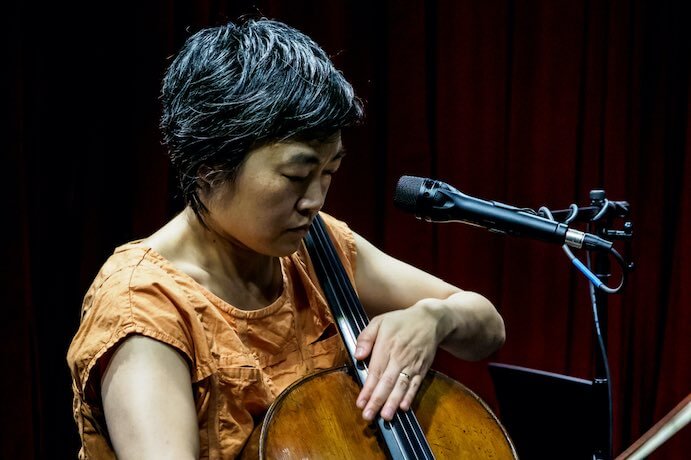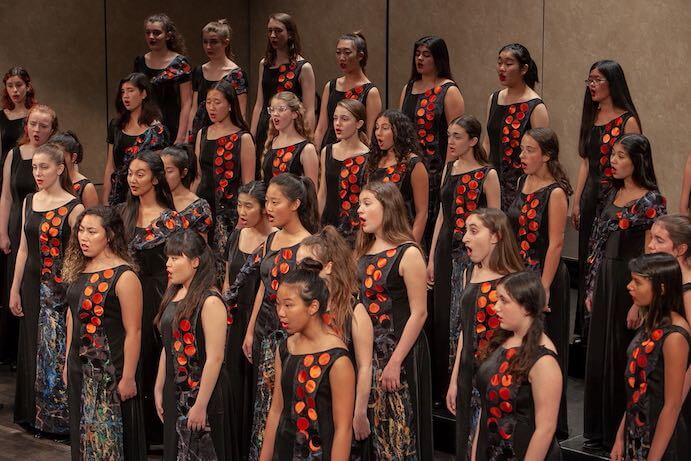The music of composer, cellist, and vocalist Theresa Wong bridges the disciplines of classical music, visual art, and theater. Her compositions are exciting, innovative, collaborative, and often experimental or improvisatory. An active performer herself, Theresa is also the founder of a record label, fo’c’sle, which is “dedicated to adventurous music from the Bay Area and beyond.”
Recently, the San Francisco Girls Chorus (SFGC), led by Valérie Sainte-Agathe, commissioned Wong to compose a choral work to be premiered by the ensemble on March 13, 2022 at the Bayview Opera House in San Francisco. The piece, In Stillness I Sing, performed with collaborator and pianist Sarah Cahill, sets the words of the young women of the SFGC to music, capturing their own reflections of their experiences during the pandemic.
Your work is frequently collaborative and often multidisciplinary in nature, and you seem to draw inspiration from so many sources. In a broad sense, how would you best describe your compositional process?
I begin through exploration. The first step often entails gathering sound possibilities on an instrument. When feasible, I learn to play the basics of an instrument for which I’m composing, and also document techniques from my own personal way of playing it. It’s very important for me to connect with performers – whether in-person or over Zoom these days – to get to know their approach to playing and to feel inspiration for the music.
In some pieces that I write in just intonation, I spend a lot of time initially considering how to structure the tuning system that I’ll use. Sometimes the thematic subject of a piece comes to me quickly, and I’ll research that topic through looking, listening, reading, watching, and conversing. Sometimes it takes me a while to figure out a thematic direction, in which case I’ll do mind-maps and gather ideas. Then, I begin creating sketches, or scribbles, as I like to call them, using MIDI or recording myself playing on an instrument. The connection of my body playing an instrument is key to my compositional process. I don’t like to just write notation from my head – it really comes from making sounds in real time through improvising and playing. Once I have a sketch recorded and notated, it goes through an iterative process of revising and refining, which I do on my own. Then, of course, the music continues to grow as I meet and work with musicians.

Composer-performers are not rare, but few composers have also founded their own recording label and work to promote not only their own music, but the music of other composers, as well. What inspired you to found fo’c’sle, and how do you decide which artists to feature on the label?
Back in 2014 when I was invited to release Venice Is A Fish as a digital album on Sensitive Skin Music, I found the experience a bit frustrating because I couldn’t give people – fans, presenters, colleagues, etc. – a physical form of the music. Eventually, I decided to design and produce a CD version myself, and enjoyed the process so much that it thrilled me to imagine giving the same care to other music that I really admired. It wasn’t until several years after that when I properly established fo’c’sle. I choose artists and projects that have a spirit of open-mindedness, invention, and exploration that is somehow connected to the history and spirit of experimentalism in California. Drawing my own inspiration from people like Henry Cowell, Harry Partch, John Cage, and Pauline Oliveros, I would say the artists I choose move freely between several areas including composition, improvisation, song forms, alternative tunings, invented instruments and electronic music. Not all artists on the label are necessarily from the Bay Area, but there is usually some point of connection.
Your new work, In Stillness I Sing for the San Francisco Girls Chorus, is inspired by the girls’ experiences of the pandemic. How has the health crisis of the last two years affected your own compositional inspiration and output?
At the beginning of the lockdown, I began to record an album of solo pieces entitled Practicing Sands, which I was originally planning to do at the Headlands Center for the Arts. For several months, I studied up on recording techniques and discovered a passion for recording as an extension of composition. Then, I was fortunate to receive several commissions throughout the pandemic and have really deepened my practice during the last two years. Slowing down and simplifying daily life has given me a chance to explore things more deeply and carefully and with a different sort of attention to detail.
At the same time, the relentless shocks and traumas of the past years (not only the pandemic but the raging wildfires here in California, the rising violence against Black and Asian lives, and the political unrest in the U.S.), drove me to connect even more strongly with my creative practice as a sort of stabilizing life raft. The limitations of not being able to meet and perform as usual also launched me more quickly into modes of working that I had long been incubating but slow to try. For example, the piece As We Breathe was created entirely remotely with the singer David Castillo in LA and constructed into a sort of filmed installation. I had long been thinking of the idea of ‘installed songs’ since a piece I did at the Headlands in 2009, but the disruptive situation kicked me into gear to really realize this non-conventional way of creating song forms.

As you set the texts of these young people for whom the pandemic hit at a particularly formative time, what moved or surprised you most about their experiences and reflections, and was it particularly challenging to capture these elements in music?
I was really moved by the sense of grace and wisdom that the young singers expressed. Of course there was sadness and anger for not being able to see friends and share pivotal high school experiences, but many of them expressed newfound connections with themselves, with close friends, family, and with nature. I didn’t find it difficult to capture this in music – rather, I was inspired quite readily by their texts. I only hope that I have treated their words with due care and set them musically in ways that honor their experiences. There was also a lot of material I didn’t even use, so part of the challenge was creating a cohesive structure from a vast and rich amount of material.
Your performance calendar is quite active with concerts taking place from San Francisco to London. What upcoming projects and performances are you most excited about?
Well, after developing In Stillness I Sing almost all virtually over the past year and a half, I am extremely excited to hear the entire piece come together for the first time, which will include all the singers led by the magnificent Valérie Sainte-Agathe, the wonderful pianist Sarah Cahill, and a taped component of audio recordings that the singers made during lockdown. But really, I look forward to all of the upcoming premieres, as I’m exploring a lot of new territory; Tuyshtak, a piece in just intonation for six clarinets of the San Francisco Conservatory of Music Clarinet Studio, and The Secret of Growth, a new work for the Pennsylvania-based NakedEye Ensemble (which I unfortunately cannot attend), which includes a video ancestral altar that I’m creating. And of course, having Sarah Cahill perform She Dances Naked Under Palm Trees at the Barbican Conservatory (of plants, not music!) in London is a real treat. After this busy month of concerts, I’m also really looking forward to designing and releasing my solo album Practicing Sands, which will come outlater this year on fo’c’sle.
I CARE IF YOU LISTEN is an editorially-independent program of the American Composers Forum, funded with generous donor and institutional support. Opinions expressed are solely those of the author and may not represent the views of ICIYL or ACF.
A gift to ACF helps support the work of ICIYL. For more on ACF, visit the “At ACF” section or composersforum.org.
























